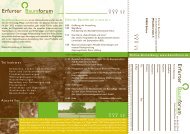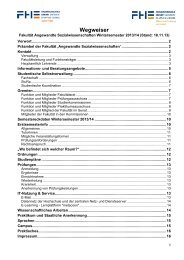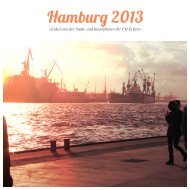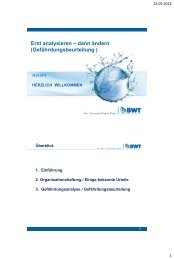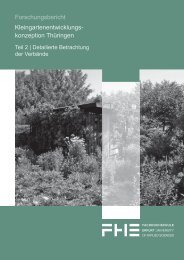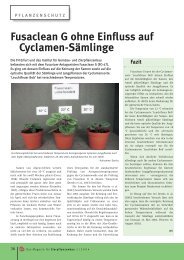Effects of Natural and Human Disturbances on Floodplain Vegetation
Effects of Natural and Human Disturbances on Floodplain Vegetation
Effects of Natural and Human Disturbances on Floodplain Vegetation
You also want an ePaper? Increase the reach of your titles
YUMPU automatically turns print PDFs into web optimized ePapers that Google loves.
<str<strong>on</strong>g>Effects</str<strong>on</strong>g> <str<strong>on</strong>g>of</str<strong>on</strong>g> <str<strong>on</strong>g>Natural</str<strong>on</strong>g> <str<strong>on</strong>g>and</str<strong>on</strong>g> <str<strong>on</strong>g>Human</str<strong>on</strong>g> <str<strong>on</strong>g>Disturbances</str<strong>on</strong>g><br />
<strong>on</strong> <strong>Floodplain</strong> Vegetati<strong>on</strong><br />
Norbert Miiller<br />
Dr., Priv.-Doz. for Vegetati<strong>on</strong> Ecology at Technical University Berlin,<br />
Office for Nature C<strong>on</strong>servati<strong>on</strong>, Dr. Ziegenspeckweg 10, 86 16 1 Augsburg, Germany<br />
Riparian l<str<strong>on</strong>g>and</str<strong>on</strong>g>scapes are dynamic ecosystems. Under natural c<strong>on</strong>diti<strong>on</strong>s there is a high disturbance<br />
<str<strong>on</strong>g>of</str<strong>on</strong>g> the floodplain vegetati<strong>on</strong> by the dynamic <str<strong>on</strong>g>of</str<strong>on</strong>g> flooding <str<strong>on</strong>g>and</str<strong>on</strong>g> the change between erosi<strong>on</strong> <str<strong>on</strong>g>and</str<strong>on</strong>g><br />
accumulati<strong>on</strong> <str<strong>on</strong>g>of</str<strong>on</strong>g> bedloads. Today in most river ecosystems natural disturbances are altered or<br />
replaced by human disturbances due to civil engineering measures. Flood c<strong>on</strong>trolling <str<strong>on</strong>g>and</str<strong>on</strong>g> reducti<strong>on</strong><br />
<str<strong>on</strong>g>of</str<strong>on</strong>g> bedloads cause fundamental changes in structure <str<strong>on</strong>g>and</str<strong>on</strong>g> species combinati<strong>on</strong> <str<strong>on</strong>g>of</str<strong>on</strong>g> the floodplain<br />
vegetati<strong>on</strong>. The effects are obvious in most rivers <str<strong>on</strong>g>of</str<strong>on</strong>g> the industrial countries: there is a decrease or<br />
extincti<strong>on</strong> <str<strong>on</strong>g>of</str<strong>on</strong>g> typical plants <str<strong>on</strong>g>and</str<strong>on</strong>g> biocoenoses.<br />
In this presentati<strong>on</strong> the effects <str<strong>on</strong>g>of</str<strong>on</strong>g> natural <str<strong>on</strong>g>and</str<strong>on</strong>g> human disturbances <strong>on</strong> the floodplain vegetati<strong>on</strong> is<br />
shown by example <str<strong>on</strong>g>of</str<strong>on</strong>g> the vegetati<strong>on</strong> <strong>on</strong> gravelbars <str<strong>on</strong>g>of</str<strong>on</strong>g> braided rivers. By comparing natural <str<strong>on</strong>g>and</str<strong>on</strong>g><br />
impacted rivers courses we can dem<strong>on</strong>strate how disturbances are important for:<br />
- the structure <str<strong>on</strong>g>and</str<strong>on</strong>g> dynamic <str<strong>on</strong>g>of</str<strong>on</strong>g> vegetati<strong>on</strong><br />
- the survival <str<strong>on</strong>g>of</str<strong>on</strong>g> plant populati<strong>on</strong>s<br />
- the diffusi<strong>on</strong> <str<strong>on</strong>g>of</str<strong>on</strong>g> plants<br />
Under natural c<strong>on</strong>diti<strong>on</strong>s the variety <str<strong>on</strong>g>of</str<strong>on</strong>g> disturbances supports the variati<strong>on</strong> <str<strong>on</strong>g>of</str<strong>on</strong>g> species <str<strong>on</strong>g>and</str<strong>on</strong>g> plant<br />
communities (high biodiversity) in river ecosystems. As result <str<strong>on</strong>g>of</str<strong>on</strong>g> human disturbances the high<br />
biodiversity in river ecosystems is reduced <str<strong>on</strong>g>and</str<strong>on</strong>g> plants especially adapted to natural disturbances are<br />
faced with extincti<strong>on</strong>. In c<strong>on</strong>sequence nature c<strong>on</strong>servati<strong>on</strong> <str<strong>on</strong>g>and</str<strong>on</strong>g> restorati<strong>on</strong> <str<strong>on</strong>g>of</str<strong>on</strong>g> riparian l<str<strong>on</strong>g>and</str<strong>on</strong>g>scapes<br />
must focus <strong>on</strong> the preservati<strong>on</strong> or restorati<strong>on</strong> <str<strong>on</strong>g>of</str<strong>on</strong>g> natural disturbances in this ecosystem.<br />
Keywords: biodiversity, braided rivers, civil engineering measures, gravelbar vegetati<strong>on</strong>,<br />
hydrodynat?iics, morphodynamics, plant diffusi<strong>on</strong>, vegetati<strong>on</strong> structure<br />
l. Introducti<strong>on</strong><br />
In ecology disturbance is defined as ,,any relatively discrete event in time that removes organisms <str<strong>on</strong>g>and</str<strong>on</strong>g> opens<br />
space which can be col<strong>on</strong>ised by individuals <str<strong>on</strong>g>of</str<strong>on</strong>g> the same or different species" (Beg<strong>on</strong> et al. 1990, Sousa 1984).<br />
<str<strong>on</strong>g>Natural</str<strong>on</strong>g> disturbances <str<strong>on</strong>g>and</str<strong>on</strong>g> stochastical events can be observed in many ecosystems, for example fire in forest<br />
ecosystems, inundati<strong>on</strong> in river ecosystems <str<strong>on</strong>g>and</str<strong>on</strong>g> avalanches in mountain ecosystems. <str<strong>on</strong>g>Human</str<strong>on</strong>g> disturbances are<br />
the dominant ecological factor <str<strong>on</strong>g>of</str<strong>on</strong>g> all man-made ecosystems like plugging or cutting in agricultural ecosystems,<br />
soil accumulati<strong>on</strong> or dismantling in urban ecosystems. <str<strong>on</strong>g>Human</str<strong>on</strong>g> disturbances can influence or replace natural<br />
disturbances too, for example flood c<strong>on</strong>trolling in river ecosystems.<br />
The effects <str<strong>on</strong>g>of</str<strong>on</strong>g> natural disturbances <strong>on</strong> community structure <str<strong>on</strong>g>and</str<strong>on</strong>g> species diversity are well researched in forest<br />
ecosystems (e. g. Denslow 1995) <str<strong>on</strong>g>and</str<strong>on</strong>g> natural grassl<str<strong>on</strong>g>and</str<strong>on</strong>g>s (e. g. Collines et al. 1995). An overview <str<strong>on</strong>g>of</str<strong>on</strong>g> the scales<br />
<str<strong>on</strong>g>and</str<strong>on</strong>g> the effects <str<strong>on</strong>g>of</str<strong>on</strong>g> natural disturbances in different ecosystems is presented in White <str<strong>on</strong>g>and</str<strong>on</strong>g> Pickett (l 985). These<br />
investigati<strong>on</strong>s led in principle to a better underst<str<strong>on</strong>g>and</str<strong>on</strong>g>ing <str<strong>on</strong>g>of</str<strong>on</strong>g> the dynamics as fundamental factors in<br />
communities. While most research <strong>on</strong> natural disturbances is d<strong>on</strong>e in North America, in Europe ecological<br />
science focuses <strong>on</strong> man made ecosystems. Under the aspect <str<strong>on</strong>g>of</str<strong>on</strong>g> vegetati<strong>on</strong> dynamics the effect <str<strong>on</strong>g>of</str<strong>on</strong>g> cutting is<br />
researched in different grassl<str<strong>on</strong>g>and</str<strong>on</strong>g>s e. g. semidry grassl<str<strong>on</strong>g>and</str<strong>on</strong>g>s <str<strong>on</strong>g>and</str<strong>on</strong>g> wetl<str<strong>on</strong>g>and</str<strong>on</strong>g>s. In recent times is there a growing<br />
c<strong>on</strong>cern <strong>on</strong> the importance <str<strong>on</strong>g>of</str<strong>on</strong>g> natural disturbances <str<strong>on</strong>g>and</str<strong>on</strong>g> stochastical events under the aspect <str<strong>on</strong>g>of</str<strong>on</strong>g> nature<br />
c<strong>on</strong>servati<strong>on</strong> (e. g. Plachter 1996).<br />
This paper dem<strong>on</strong>strates the importance <str<strong>on</strong>g>of</str<strong>on</strong>g> disturbances in riparian ecosystems by example <str<strong>on</strong>g>of</str<strong>on</strong>g> the floodplain<br />
vegetati<strong>on</strong> <str<strong>on</strong>g>and</str<strong>on</strong>g> with special regard to nature c<strong>on</strong>servati<strong>on</strong>.<br />
kparian l<str<strong>on</strong>g>and</str<strong>on</strong>g>scapes are especially dynamic ecosystems. Under natural c<strong>on</strong>diti<strong>on</strong>s there is a high disturbance<br />
by the dynamic <str<strong>on</strong>g>of</str<strong>on</strong>g> flooding <str<strong>on</strong>g>and</str<strong>on</strong>g> the transportati<strong>on</strong> <str<strong>on</strong>g>of</str<strong>on</strong>g> bedloads. These disturbances are especially str<strong>on</strong>g in<br />
braided rivers, when erosi<strong>on</strong> <str<strong>on</strong>g>and</str<strong>on</strong>g> accumulati<strong>on</strong> <str<strong>on</strong>g>of</str<strong>on</strong>g> bedloads are in balance. Typical <str<strong>on</strong>g>of</str<strong>on</strong>g> these rivers are
floodplains with a large littoral z<strong>on</strong>e <str<strong>on</strong>g>of</str<strong>on</strong>g> gravel bars, without or scarcely covered with vegetati<strong>on</strong>. This type <str<strong>on</strong>g>of</str<strong>on</strong>g><br />
river is predominant in alpine <str<strong>on</strong>g>and</str<strong>on</strong>g> pre-alpine regi<strong>on</strong>s e.g. the European Alps, the Rocky Mountains, the<br />
fimalayas <str<strong>on</strong>g>and</str<strong>on</strong>g> also in the Japanese Alps.<br />
Today in most river ecosystems natural disturbances are altered or replaced by human disturbances: dams<br />
c<strong>on</strong>trol flooding <str<strong>on</strong>g>and</str<strong>on</strong>g> hinder bedload transportati<strong>on</strong> (e. g. Miiller 1995a).<br />
Only a few years ago it was recognised that these natural disturbances play an important role for the<br />
preservati<strong>on</strong> <str<strong>on</strong>g>of</str<strong>on</strong>g> the typical vegetati<strong>on</strong> <str<strong>on</strong>g>and</str<strong>on</strong>g> wildlife. Based <strong>on</strong> several examples <str<strong>on</strong>g>of</str<strong>on</strong>g> braided rivers in ths paper<br />
the effects <str<strong>on</strong>g>of</str<strong>on</strong>g> natural <str<strong>on</strong>g>and</str<strong>on</strong>g> human disturbances <strong>on</strong> the gravelbar vegetati<strong>on</strong> are shown, comparing natural <str<strong>on</strong>g>and</str<strong>on</strong>g><br />
impacted rivers courses. Questi<strong>on</strong>s are:<br />
How do natural <str<strong>on</strong>g>and</str<strong>on</strong>g> human disturbances influence<br />
- the structure <str<strong>on</strong>g>and</str<strong>on</strong>g> dynamic <str<strong>on</strong>g>of</str<strong>on</strong>g> vegetati<strong>on</strong>?<br />
- the survival <str<strong>on</strong>g>of</str<strong>on</strong>g> plant populati<strong>on</strong>s?<br />
- the diffusi<strong>on</strong> <str<strong>on</strong>g>of</str<strong>on</strong>g> plants?<br />
Finally c<strong>on</strong>clusi<strong>on</strong>s are made for nature c<strong>on</strong>servati<strong>on</strong> <str<strong>on</strong>g>and</str<strong>on</strong>g> the restorati<strong>on</strong> <str<strong>on</strong>g>of</str<strong>on</strong>g> riparian l<str<strong>on</strong>g>and</str<strong>on</strong>g>scapes.<br />
2. <str<strong>on</strong>g>Disturbances</str<strong>on</strong>g> in floodplain ecosystems<br />
2.1 <str<strong>on</strong>g>Natural</str<strong>on</strong>g> disturbances<br />
<str<strong>on</strong>g>Natural</str<strong>on</strong>g> disturbances are caused in floodplains by river dynamics, that means the hydrodynamics (change <str<strong>on</strong>g>of</str<strong>on</strong>g><br />
inundati<strong>on</strong> <str<strong>on</strong>g>and</str<strong>on</strong>g> dessicati<strong>on</strong>) <str<strong>on</strong>g>and</str<strong>on</strong>g> morphodynamics (erosi<strong>on</strong> <str<strong>on</strong>g>and</str<strong>on</strong>g> accumulati<strong>on</strong> <str<strong>on</strong>g>of</str<strong>on</strong>g> bedloads).<br />
The str<strong>on</strong>gest physical disturbance for floodplain vegetati<strong>on</strong> is caused by morphodynarnics. The main<br />
transport <str<strong>on</strong>g>of</str<strong>on</strong>g> bedloads occurs during flood water events, that means gravel <str<strong>on</strong>g>and</str<strong>on</strong>g> s<str<strong>on</strong>g>and</str<strong>on</strong>g> is transported by the power<br />
<str<strong>on</strong>g>of</str<strong>on</strong>g> the water. By this way plants <strong>on</strong> old gravelbars can be destroyed partially or totally, whereas <strong>on</strong> the other<br />
h<str<strong>on</strong>g>and</str<strong>on</strong>g> new habitats for plants are created by the accumulati<strong>on</strong> <str<strong>on</strong>g>of</str<strong>on</strong>g> bedloads.<br />
Where morphodynamics works closely the main river course, hydrodynamics influence the whole floodplain<br />
area. For plants <str<strong>on</strong>g>and</str<strong>on</strong>g> vegetati<strong>on</strong> the change between drought <str<strong>on</strong>g>and</str<strong>on</strong>g> inundati<strong>on</strong> is important. Inundati<strong>on</strong> can be<br />
c<strong>on</strong>nected with a destructi<strong>on</strong> <str<strong>on</strong>g>of</str<strong>on</strong>g> plants or parts <str<strong>on</strong>g>of</str<strong>on</strong>g> them. Hydrodynamics influence the groundwater level too.<br />
According the effects <str<strong>on</strong>g>of</str<strong>on</strong>g> these disturbances, which are different in time <str<strong>on</strong>g>and</str<strong>on</strong>g> space, natural floodplains show a<br />
typical vegetati<strong>on</strong> structure (compare fig. 1):<br />
- gravelbars, either- bare or scarcely covered with pi<strong>on</strong>eer vegetati<strong>on</strong> (herbaceous vegetati<strong>on</strong> <str<strong>on</strong>g>and</str<strong>on</strong>g> willow<br />
shrubs) are mainly influenced by morphodynarnics,<br />
- wetl<str<strong>on</strong>g>and</str<strong>on</strong>g> vegetati<strong>on</strong> al<strong>on</strong>g old channels <str<strong>on</strong>g>and</str<strong>on</strong>g> floodplain forests which are influenced by hydrodynamics can be<br />
summed up as flooding vegetati<strong>on</strong>,<br />
- fossil floodplain forests outside the actual river dynamics.<br />
Max. tiigll Wa~cr<br />
. .<br />
-----<br />
Present <strong>Floodplain</strong>s<br />
River Dynamics I<br />
IIydrodynamics<br />
I I I I l I<br />
Fossile Floodl~lains<br />
No Vegetarian Ch<strong>on</strong>drillerurn Querco-Ulrnerum Erico-Pincru~n<br />
l l<br />
Salic. elaeagni<br />
Typherurn min.<br />
etum<br />
Erica-Pinelunl Mesobrorni<strong>on</strong>-Ass.<br />
Molini<strong>on</strong>-Ass.<br />
Pio~ieer vegetati<strong>on</strong> 1 I'looclil~g Vegetati<strong>on</strong> I Dry Woo(1.s<br />
Fig. 1: Typical z<strong>on</strong>ati<strong>on</strong> <str<strong>on</strong>g>of</str<strong>on</strong>g> the floodplain vegetati<strong>on</strong> under natural disturbances at an alpine river in the<br />
European Alps (from Miiller 1995b)
2.2 <str<strong>on</strong>g>Human</str<strong>on</strong>g> disturbances<br />
In industrialised countries there has been a l<strong>on</strong>g history <str<strong>on</strong>g>of</str<strong>on</strong>g> human impact, whch influences the intensity <str<strong>on</strong>g>and</str<strong>on</strong>g><br />
effects <str<strong>on</strong>g>of</str<strong>on</strong>g> natural disturbances. In Europe for example, as far back as the St<strong>on</strong>e Age the run-<str<strong>on</strong>g>of</str<strong>on</strong>g>f <str<strong>on</strong>g>of</str<strong>on</strong>g> the large<br />
lowl<str<strong>on</strong>g>and</str<strong>on</strong>g> rivers, whch have their main catchment area in the Low Mountains, was influenced by the change <str<strong>on</strong>g>of</str<strong>on</strong>g><br />
l<str<strong>on</strong>g>and</str<strong>on</strong>g>scape in the catchment area (Litt 1992). A great change in the structure <str<strong>on</strong>g>of</str<strong>on</strong>g> lowl<str<strong>on</strong>g>and</str<strong>on</strong>g> rivers took place when<br />
agriculture increased during the Roman Times. In c<strong>on</strong>trast major intrusi<strong>on</strong>s <strong>on</strong> the natural water <str<strong>on</strong>g>and</str<strong>on</strong>g> bedload<br />
regime <str<strong>on</strong>g>of</str<strong>on</strong>g> the alpine rivers started in Europe in the Middle Ages due to an increasing number <str<strong>on</strong>g>of</str<strong>on</strong>g> settlers in the<br />
valleys <str<strong>on</strong>g>and</str<strong>on</strong>g> the clearing <str<strong>on</strong>g>of</str<strong>on</strong>g> forests in the catchment areas. C<strong>on</strong>sequent civil engineering measures, that means<br />
the regulati<strong>on</strong> <str<strong>on</strong>g>of</str<strong>on</strong>g> rivers <str<strong>on</strong>g>and</str<strong>on</strong>g> the c<strong>on</strong>structi<strong>on</strong> <str<strong>on</strong>g>of</str<strong>on</strong>g> hydroelectric power plants, finally started in most industrial<br />
countries in the 19 th century <str<strong>on</strong>g>and</str<strong>on</strong>g> early 20 th century. Today almost 80 % <str<strong>on</strong>g>of</str<strong>on</strong>g> the total water discharge <str<strong>on</strong>g>of</str<strong>on</strong>g> the<br />
139 largest river systems in North America, Europe <str<strong>on</strong>g>and</str<strong>on</strong>g> the former Soviet uni<strong>on</strong> is str<strong>on</strong>gly or moderately<br />
affected by fragmentati<strong>on</strong> <str<strong>on</strong>g>of</str<strong>on</strong>g> the river channels by dams <str<strong>on</strong>g>and</str<strong>on</strong>g> by water regulati<strong>on</strong> resulting from reservoir<br />
operati<strong>on</strong>, interbasin diversi<strong>on</strong> <str<strong>on</strong>g>and</str<strong>on</strong>g> irrigati<strong>on</strong> (Dynesius <str<strong>on</strong>g>and</str<strong>on</strong>g> Nils<strong>on</strong> 1994).<br />
These human impacts lead in general to a decrease <str<strong>on</strong>g>of</str<strong>on</strong>g> the natural river dynamics especially the dynamic <str<strong>on</strong>g>of</str<strong>on</strong>g><br />
morphology <str<strong>on</strong>g>and</str<strong>on</strong>g> hydrology. Nowadays disturbances in floodplains are <str<strong>on</strong>g>of</str<strong>on</strong>g>ten influenced by man al<strong>on</strong>e: power,<br />
time <str<strong>on</strong>g>and</str<strong>on</strong>g> frequency <str<strong>on</strong>g>of</str<strong>on</strong>g> flooding <str<strong>on</strong>g>and</str<strong>on</strong>g> bedload transportati<strong>on</strong> are c<strong>on</strong>trolled by hydroelectric paw$ plants<br />
(Miiller 1995a). Regarding to hydrodynamics the peaks <str<strong>on</strong>g>of</str<strong>on</strong>g> flooding are lowered <str<strong>on</strong>g>and</str<strong>on</strong>g> the lowest values are<br />
raised in order to use the waterflow most ec<strong>on</strong>omicly. Where swell dams are used the water level changes<br />
daily. Regarding morphodynamics, dams have the effect <str<strong>on</strong>g>of</str<strong>on</strong>g> completely retaining the bedload gravel <str<strong>on</strong>g>and</str<strong>on</strong>g> <str<strong>on</strong>g>of</str<strong>on</strong>g><br />
being effective traps for suspensi<strong>on</strong> material. Due to the lack <str<strong>on</strong>g>of</str<strong>on</strong>g> debris downstream <str<strong>on</strong>g>of</str<strong>on</strong>g> a dam, the river is<br />
forced to compensate its capacity <str<strong>on</strong>g>of</str<strong>on</strong>g> transportati<strong>on</strong> to the side <str<strong>on</strong>g>and</str<strong>on</strong>g> river bed erosi<strong>on</strong>. The result is that in<br />
impacted rivers the morphodynarnics get lost <str<strong>on</strong>g>and</str<strong>on</strong>g> reduced hydrodynamics occur. In impacted rivers the<br />
floodplain vegetati<strong>on</strong> is therefore changing. The pi<strong>on</strong>eer vegetati<strong>on</strong> declines <str<strong>on</strong>g>and</str<strong>on</strong>g> becomes extinct. Only<br />
vegetati<strong>on</strong> types adapted to flooding predominates. Due to the river bed erosi<strong>on</strong> the area which is influenced by<br />
flooding has decreased <str<strong>on</strong>g>and</str<strong>on</strong>g> fossil floodplain forests have increased (compare fig. 2).<br />
Present Flood plains<br />
. I w M w . - - -<br />
River Dynamics<br />
l<br />
Fossile <strong>Floodplain</strong>s<br />
Flooding Vegetatio~l ( Dry Woods I Agricultural <str<strong>on</strong>g>and</str<strong>on</strong>g> Urban Arras<br />
Fig. 2: Typical z<strong>on</strong>ati<strong>on</strong> <str<strong>on</strong>g>of</str<strong>on</strong>g> the floodplain vegetati<strong>on</strong> under human disturbances (upstream dams) at an alpine<br />
river in the European Alps (from Muller 1995b)<br />
3. <str<strong>on</strong>g>Effects</str<strong>on</strong>g> <str<strong>on</strong>g>of</str<strong>on</strong>g> natural <str<strong>on</strong>g>and</str<strong>on</strong>g> human disturbances<br />
3.1 On the structure <str<strong>on</strong>g>and</str<strong>on</strong>g> dynamic <str<strong>on</strong>g>of</str<strong>on</strong>g> the gravelbar vegetati<strong>on</strong><br />
<str<strong>on</strong>g>Natural</str<strong>on</strong>g> disturbances caused by morphodynamics set the plant communities <strong>on</strong> gravelbars back to an earlier<br />
stage <str<strong>on</strong>g>of</str<strong>on</strong>g> successi<strong>on</strong> or even back to their starting points. Because <str<strong>on</strong>g>of</str<strong>on</strong>g> this, plants that are str<strong>on</strong>g competitors are
hindered regularly <strong>on</strong> their way to dominati<strong>on</strong>, so that plants which are weak competitors also get the<br />
opportunity to survive at the site. Large gravel bars in natural alpine floodplains, covered <strong>on</strong>ly partially by<br />
hlgher plants, make these effects visible (fig. 1). Under natural c<strong>on</strong>diti<strong>on</strong>s <strong>on</strong>ly herbaceous species with special<br />
adaptati<strong>on</strong>s <str<strong>on</strong>g>and</str<strong>on</strong>g> pi<strong>on</strong>eer shrubs grow in these places. Regarding phytosociological groups they can be<br />
separated in 4 groups (compare fig. 4, left side):<br />
a) species <str<strong>on</strong>g>of</str<strong>on</strong>g> natural floodplains, that means species which live <strong>on</strong>ly in this habitat <str<strong>on</strong>g>and</str<strong>on</strong>g> whch have special<br />
adaptati<strong>on</strong>s to the natural disturbances in this habitat (e. g. Myricaria germanica Desv. <str<strong>on</strong>g>and</str<strong>on</strong>g> Calamagrostis<br />
pseudophragmites Koeler comp. 3.2),<br />
b) species from dry grassl<str<strong>on</strong>g>and</str<strong>on</strong>g> can grow <strong>on</strong> gravelbars because in summer time there are l<strong>on</strong>ger periods <str<strong>on</strong>g>of</str<strong>on</strong>g><br />
dryness.<br />
Under natural c<strong>on</strong>diti<strong>on</strong>s there are also, with lower frequency:<br />
c) species <str<strong>on</strong>g>of</str<strong>on</strong>g> ruderal communities, that means comm<strong>on</strong> species <str<strong>on</strong>g>of</str<strong>on</strong>g> habitats with human disturbances for<br />
example <str<strong>on</strong>g>of</str<strong>on</strong>g> urban areas or arable fields,<br />
d) species <str<strong>on</strong>g>of</str<strong>on</strong>g> wetl<str<strong>on</strong>g>and</str<strong>on</strong>g>s meaning comm<strong>on</strong> species with a wide ecological amplitude which grow in different wet<br />
habitats (e. g. Phalaris arundinacea L.).<br />
How vegetati<strong>on</strong> structure <strong>on</strong> gravelbars is changing after loss <str<strong>on</strong>g>of</str<strong>on</strong>g> natural disturbances <str<strong>on</strong>g>and</str<strong>on</strong>g> under influence <str<strong>on</strong>g>of</str<strong>on</strong>g><br />
human disturbances is shown by comparing the gravelbar vegetati<strong>on</strong> at the Lech river in the European Alps<br />
before <str<strong>on</strong>g>and</str<strong>on</strong>g> after the c<strong>on</strong>structi<strong>on</strong> <str<strong>on</strong>g>of</str<strong>on</strong>g> upstream dams. Al<strong>on</strong>g an unregulated course .the gravelbar vegetati<strong>on</strong> has<br />
changed fundamentally within 30 years. Gravelbars without vegetati<strong>on</strong> <str<strong>on</strong>g>and</str<strong>on</strong>g> with pi<strong>on</strong>eer vegetati<strong>on</strong> <str<strong>on</strong>g>and</str<strong>on</strong>g> open<br />
willow shrubs are decreasing. On the c<strong>on</strong>trary flooding, vegetati<strong>on</strong>, dense willow shrubs <str<strong>on</strong>g>and</str<strong>on</strong>g> floodplain forests<br />
are increasing (fig. 3). This development can also be observed in other braided rivers <str<strong>on</strong>g>of</str<strong>on</strong>g> the temperate z<strong>on</strong>e<br />
after the c<strong>on</strong>structi<strong>on</strong> <str<strong>on</strong>g>of</str<strong>on</strong>g> dams (e. g. Bravard et al. 1986, Miiller 1995b, Okuda et al. 1995).<br />
water<br />
bare gravelbars <str<strong>on</strong>g>and</str<strong>on</strong>g><br />
pi<strong>on</strong>eer vegetati<strong>on</strong><br />
flooding vegetati<strong>on</strong><br />
open willow shrubs<br />
dense willow shrubs<br />
floodplain forests<br />
r-<br />
1959<br />
1991 1<br />
Fig. 3: Alterati<strong>on</strong>s <str<strong>on</strong>g>of</str<strong>on</strong>g> vegetati<strong>on</strong> structure <strong>on</strong> gravelbars after the c<strong>on</strong>structi<strong>on</strong> <str<strong>on</strong>g>of</str<strong>on</strong>g> upstream dams at the Lech<br />
river in the European Alps (after Miiller 1995a)
Regarding the species combinati<strong>on</strong> <strong>on</strong> the gravelbars, species <str<strong>on</strong>g>of</str<strong>on</strong>g> natural floodplains <str<strong>on</strong>g>and</str<strong>on</strong>g> <str<strong>on</strong>g>of</str<strong>on</strong>g> dry grassl<str<strong>on</strong>g>and</str<strong>on</strong>g>s<br />
(pi<strong>on</strong>eer vegetati<strong>on</strong>) are decreasing, whereas species <str<strong>on</strong>g>of</str<strong>on</strong>g> ruderal communities <str<strong>on</strong>g>and</str<strong>on</strong>g> wetl<str<strong>on</strong>g>and</str<strong>on</strong>g>s (flooding<br />
vegetati<strong>on</strong>) are increasing. These also lead to a lowering <str<strong>on</strong>g>of</str<strong>on</strong>g> species diversity because <strong>on</strong>ly competitive species<br />
are able to survive (fig. 4). Species highly specialised to natural disturbances become extinct (cornp. 3.2).<br />
Species no. <str<strong>on</strong>g>of</str<strong>on</strong>g> natural floodplains<br />
wetl<str<strong>on</strong>g>and</str<strong>on</strong>g>s<br />
Fig. 1: Alterati<strong>on</strong>s <str<strong>on</strong>g>of</str<strong>on</strong>g> species richness <str<strong>on</strong>g>and</str<strong>on</strong>g> -combinati<strong>on</strong> <strong>on</strong> gravelbars after the c<strong>on</strong>structi<strong>on</strong> <str<strong>on</strong>g>of</str<strong>on</strong>g> upstream dams<br />
at the Lech river in the European Alps (according 25 relevees from Muller 1995b)<br />
ln\.estigati<strong>on</strong>s into nutrients have shown that, in river courses with natural disturbances the nutrients<br />
3~ allable to plants <strong>on</strong> gravelbars are low in c<strong>on</strong>trast to river courses impacted by dams. Under the influence <str<strong>on</strong>g>of</str<strong>on</strong>g><br />
&IS bedload transportati<strong>on</strong> is stopped <str<strong>on</strong>g>and</str<strong>on</strong>g> the extremes <str<strong>on</strong>g>of</str<strong>on</strong>g> hydrodynamics are lowered. Plant successi<strong>on</strong> <str<strong>on</strong>g>and</str<strong>on</strong>g><br />
911 development <strong>on</strong> gravelbars are as a c<strong>on</strong>sequence no l<strong>on</strong>ger interrupted regularly <str<strong>on</strong>g>and</str<strong>on</strong>g> therefore nutrients<br />
xrcase in the soil (cornp. fig. 5).<br />
Nitrogen<br />
n<br />
Herbaceous Shrubbery Herbaceous<br />
gravel bar<br />
gravel bar<br />
gravelbar<br />
vegetati<strong>on</strong><br />
vegetat<strong>on</strong><br />
vegetati<strong>on</strong><br />
1 natural floodplains H impacted floodplains 1<br />
10<br />
Phosphorous<br />
Shrubbery<br />
gravelbar<br />
vegetati<strong>on</strong><br />
Fig. S: Plant available nutrients <strong>on</strong> gravelbars <str<strong>on</strong>g>of</str<strong>on</strong>g> natural <str<strong>on</strong>g>and</str<strong>on</strong>g> impacted (by dams) floodplains at the Lech river<br />
is the European Alps (according Muller 1995a)
With the change <str<strong>on</strong>g>of</str<strong>on</strong>g> the hsturbance regime recol<strong>on</strong>isati<strong>on</strong> processes are also altered, that means the way in<br />
whch new gravelbars are col<strong>on</strong>ised after a physical disturbance (compare fig. 6). In natural river courses the<br />
seed rain <str<strong>on</strong>g>of</str<strong>on</strong>g> the gravel bar vegetati<strong>on</strong> is dominated by plumed seeds (trichometeorochores), which can be<br />
transported by wind over great distances. Seeds dispersed by gravity (barochores) dominate in impacted<br />
courses. No persistent seed bank could be detected in the gravelbar vegetati<strong>on</strong> <str<strong>on</strong>g>of</str<strong>on</strong>g> natural floodplains, whereas<br />
in impacted floodplains a persistent seed bank is well developed (fig. 6). In each case, optimal regenerati<strong>on</strong><br />
strategies are realised according to the habitat c<strong>on</strong>diti<strong>on</strong>s. In natural floodplains, newly created gravel bars can<br />
be col<strong>on</strong>ised quickly by species with far-ranging dispersal mechanisms. They are less competitive <str<strong>on</strong>g>and</str<strong>on</strong>g> develop<br />
no persistent seed bank as it may be destroyed at any time in this dynamic habitat. In impacted floodplains,<br />
where river dynamic is reduced, competitive species which develop a persistent seed bank dominate (Miiller<br />
<str<strong>on</strong>g>and</str<strong>on</strong>g> Scharm 1998).<br />
80<br />
60<br />
40<br />
20<br />
0<br />
<str<strong>on</strong>g>Natural</str<strong>on</strong>g><br />
floodplains<br />
Dispersal mechanism<br />
Wind dispersal: trichometeorochores<br />
Wind dispersal: other anemochores<br />
Gravity dispersal: barochores<br />
seed rain<br />
Impact.<br />
floodplains<br />
<str<strong>on</strong>g>Natural</str<strong>on</strong>g><br />
floodplains<br />
Impact.<br />
flood plains<br />
Fig. 6: For recol<strong>on</strong>isati<strong>on</strong> important mechanisms (seed rain <str<strong>on</strong>g>and</str<strong>on</strong>g> seed bank) <strong>on</strong> gravelbars <str<strong>on</strong>g>of</str<strong>on</strong>g> natural <str<strong>on</strong>g>and</str<strong>on</strong>g><br />
impacted floodplains at the Lech river in the European Alps (according Miiller <str<strong>on</strong>g>and</str<strong>on</strong>g> Scharm 1998)<br />
3.2 On the survival <str<strong>on</strong>g>of</str<strong>on</strong>g> populati<strong>on</strong>s<br />
<str<strong>on</strong>g>Natural</str<strong>on</strong>g> disturbances are an important factor for .the survival <str<strong>on</strong>g>of</str<strong>on</strong>g> typical floodplain species (species <str<strong>on</strong>g>of</str<strong>on</strong>g> the<br />
pi<strong>on</strong>eer vegetati<strong>on</strong>). Different investigati<strong>on</strong>s into populati<strong>on</strong> biology in recent years made this obvious (Bill et<br />
al. 1997, Miiller <str<strong>on</strong>g>and</str<strong>on</strong>g> Scharm 1998). In <strong>on</strong>e way typical floodplain species have special adaptati<strong>on</strong>s to<br />
disturbances in their life form <str<strong>on</strong>g>and</str<strong>on</strong>g> cycle. In another way they become extinct if the frequency <str<strong>on</strong>g>of</str<strong>on</strong>g> natural<br />
disturbances is changed under the human impact.<br />
A well researched species is Myricaria germanica Desv. a typical pi<strong>on</strong>eer shrub <strong>on</strong> gravelbars in braided<br />
alpine rivers in the temperate z<strong>on</strong>e <str<strong>on</strong>g>of</str<strong>on</strong>g> Europe <str<strong>on</strong>g>and</str<strong>on</strong>g> Asia (Bill et al. 1997). Myricaria germanica is adapted to<br />
the lack <str<strong>on</strong>g>of</str<strong>on</strong>g> water by a small leaf surface (protecti<strong>on</strong> from evaporati<strong>on</strong>). Each plant has developed a l<strong>on</strong>g root<br />
system which allows it to reach the ground-water or the pressure-water even in the case <str<strong>on</strong>g>of</str<strong>on</strong>g> low water level.<br />
Due to the fact that the seeds are distributed a l<strong>on</strong>g way by the wind, the plant is well adapted to space<br />
isolati<strong>on</strong> <str<strong>on</strong>g>and</str<strong>on</strong>g> therefore able to inhabit newly created habitats after a highwater event (Miiller <str<strong>on</strong>g>and</str<strong>on</strong>g> Scharm<br />
1998), which also can render local populati<strong>on</strong>s extinct. There is no such thing as a l<strong>on</strong>g living seedbank, but<br />
due to a l<strong>on</strong>g life expectancy (up to 70 years) the species is well adapted to temporal isolati<strong>on</strong>. If covered by<br />
debris, individuals are able to spread vegetatively by developing polycorm<strong>on</strong>es (Miiller 1995a).<br />
Besides these adaptati<strong>on</strong>s to natural disturbances in floodplains this species also makes special dem<str<strong>on</strong>g>and</str<strong>on</strong>g>s <strong>on</strong><br />
the habitat, which can <strong>on</strong>ly be hlfilled by a river with natural dynamics. The establishment <str<strong>on</strong>g>of</str<strong>on</strong>g> seeds depends<br />
<strong>on</strong> the period when the flood water is flowing away. The germinati<strong>on</strong> <str<strong>on</strong>g>of</str<strong>on</strong>g> the seeds <strong>on</strong>ly takes place in moist<br />
s<str<strong>on</strong>g>and</str<strong>on</strong>g>y substrate <strong>on</strong> bare gravelbars <str<strong>on</strong>g>and</str<strong>on</strong>g> has to happen rather quickly. Investigati<strong>on</strong>s <strong>on</strong> germinati<strong>on</strong> have
proven that the first seeds start to germinate after four hours <str<strong>on</strong>g>and</str<strong>on</strong>g> that 94 % after twenty hours have<br />
germinated. Therefore the success <str<strong>on</strong>g>of</str<strong>on</strong>g> recruitment depends <strong>on</strong> the fact that new habitats with bare soils are<br />
available for establishment regularly. <str<strong>on</strong>g>Natural</str<strong>on</strong>g> disturbances especially the morphodynamics fulfils these<br />
c<strong>on</strong>diti<strong>on</strong>s. If the frequency <str<strong>on</strong>g>and</str<strong>on</strong>g> the power <str<strong>on</strong>g>of</str<strong>on</strong>g> disturbances are lowered under human disturbances (e. g. dams),<br />
plant successi<strong>on</strong> <strong>on</strong> gravelbars c<strong>on</strong>tinues <str<strong>on</strong>g>and</str<strong>on</strong>g> is not interrupted through the flooding. Therefore no bare<br />
gravelbars are available after the flooding <str<strong>on</strong>g>and</str<strong>on</strong>g> Myricaria germanica is not able to recruit <str<strong>on</strong>g>and</str<strong>on</strong>g> finally become<br />
extinct under the competiti<strong>on</strong> <str<strong>on</strong>g>of</str<strong>on</strong>g> willows (compare fig. 7). As in most alpine rivers in Europe the hsturbance<br />
frequency is lowered by dams, the populati<strong>on</strong>s <str<strong>on</strong>g>of</str<strong>on</strong>g> Myricaria germanica have declined <str<strong>on</strong>g>and</str<strong>on</strong>g> become extinct (Bill<br />
et al. 1997, Miiller 1995b).<br />
-.--.-<br />
Percentaee <str<strong>on</strong>g>of</str<strong>on</strong>g> recruitment<br />
0<br />
in local populati<strong>on</strong>s<br />
Rivers<br />
0%<br />
El -15 %<br />
Border 16-35 %<br />
36-55 %<br />
Settlements 56-100 %<br />
Kochelsee 6<br />
Disturbance regime:<br />
1 = <str<strong>on</strong>g>Natural</str<strong>on</strong>g> morpho- <str<strong>on</strong>g>and</str<strong>on</strong>g> hydrodynamics<br />
2 = <str<strong>on</strong>g>Natural</str<strong>on</strong>g> morphodynamics, hydrodynamics<br />
lowered by upstream dams<br />
3 = no morphodynamics <str<strong>on</strong>g>and</str<strong>on</strong>g> hydrodynamics<br />
lowered by upstream dams<br />
Fig. 7: Recruitment <str<strong>on</strong>g>of</str<strong>on</strong>g> Myricaria gerrnanica Desv. - a typical pi<strong>on</strong>eer shrub <strong>on</strong> gravelbars - at three sites <str<strong>on</strong>g>of</str<strong>on</strong>g> the<br />
upper Isar (Northern European Alps) with different disturbance regime (after Plachter 1996)<br />
Similar strategies in the life cycle were observed from other species <str<strong>on</strong>g>of</str<strong>on</strong>g> braided rivers such as Myricaria<br />
germanica. Aster kant<strong>on</strong>ensis Kitam., a perennial herb <str<strong>on</strong>g>of</str<strong>on</strong>g> the Compositae is a rare endemic plant in braided<br />
rivers in Japan. The species has the capability for wide seed dispersal <str<strong>on</strong>g>and</str<strong>on</strong>g> fast germinati<strong>on</strong> <strong>on</strong> bare gravelbars.<br />
After highwater events local populati<strong>on</strong>s can become extinct, but also newly created gravelbars can be<br />
col<strong>on</strong>ised quickly by wide wind dispersal. Due to the loss <str<strong>on</strong>g>of</str<strong>on</strong>g> the morphodynamics as a result <str<strong>on</strong>g>of</str<strong>on</strong>g> dam<br />
c<strong>on</strong>structi<strong>on</strong> at most Japanese rivers the species Aster kant<strong>on</strong>ensis has no suitable establishment c<strong>on</strong>diti<strong>on</strong>s<br />
<str<strong>on</strong>g>and</str<strong>on</strong>g> is therefore highly endangered today (Takenaka et al. 1996, Washitani 1997).<br />
These examples make the fact that natural disturbances can destroy local plant populati<strong>on</strong>s obvious but are<br />
important for the recruitment <str<strong>on</strong>g>of</str<strong>on</strong>g> specially adapted species <str<strong>on</strong>g>and</str<strong>on</strong>g> therefore play a central role in the survival <str<strong>on</strong>g>of</str<strong>on</strong>g><br />
meta populati<strong>on</strong>s (Reich <str<strong>on</strong>g>and</str<strong>on</strong>g> Grirnrn 1996).
3.3 On the diffusi<strong>on</strong> <str<strong>on</strong>g>of</str<strong>on</strong>g> plants<br />
IClparian l<str<strong>on</strong>g>and</str<strong>on</strong>g>scapes are famous as being important corridors for plant diffusi<strong>on</strong> (e. g. Johanss<strong>on</strong> et al. 1996,<br />
van der Pijl 1982). Braided rivers with origin in the alpine z<strong>on</strong>e are under natural c<strong>on</strong>diti<strong>on</strong>s especially famous<br />
as corridors for alpine species. Light preferring plants whch have their main habitat <strong>on</strong> disturbed sites in the<br />
mountains (e. g. screes slopes), also find ecological niches <strong>on</strong> gravelbars in the fore l<str<strong>on</strong>g>and</str<strong>on</strong>g>, due to the hgh<br />
natural disturbances <strong>on</strong> these sites. Ths is especially proven for rivers in the Carpathian Mountains (Walas<br />
1938) <str<strong>on</strong>g>and</str<strong>on</strong>g> the European Alps (Miiller 1990).<br />
As the natural disturbances have been reduced due to the c<strong>on</strong>structi<strong>on</strong> <str<strong>on</strong>g>of</str<strong>on</strong>g> dams, the ecological niches for light<br />
preferring species from the alpine regi<strong>on</strong> were destroyed in riparian l<str<strong>on</strong>g>and</str<strong>on</strong>g>scapes. Additi<strong>on</strong>ally dams functi<strong>on</strong> as<br />
barriers for seed diffusi<strong>on</strong>. Therefore at impacted rivers decline <str<strong>on</strong>g>and</str<strong>on</strong>g> extincti<strong>on</strong> <str<strong>on</strong>g>of</str<strong>on</strong>g> alpine species is generally<br />
observed together with the decline <str<strong>on</strong>g>of</str<strong>on</strong>g> typical floodplain species (Miiller 1990,1995b).<br />
On the other h<str<strong>on</strong>g>and</str<strong>on</strong>g>, a fast diffusi<strong>on</strong> <str<strong>on</strong>g>of</str<strong>on</strong>g> species <str<strong>on</strong>g>of</str<strong>on</strong>g> ruderal sites can be observed today at river courses with<br />
human disturbances (comp. 3.1). When regarding their origin - beside native species from arable fields <str<strong>on</strong>g>and</str<strong>on</strong>g><br />
urban areas - we also can find alien plants. These species were introduced by man from foreign countries <str<strong>on</strong>g>and</str<strong>on</strong>g><br />
are naturalised meanwhile mainly in urban areas (Drake et a1 1989). Comparing the different types <str<strong>on</strong>g>of</str<strong>on</strong>g><br />
floodplain vegetati<strong>on</strong> the main c<strong>on</strong>centrati<strong>on</strong> <str<strong>on</strong>g>of</str<strong>on</strong>g> alien plants is in the gravelbar vegetati<strong>on</strong> (Miiller <str<strong>on</strong>g>and</str<strong>on</strong>g> Okuda<br />
1998). This is in c<strong>on</strong>trast to floodplain forests, where there are fewer invaders. Regarding the frequency <str<strong>on</strong>g>and</str<strong>on</strong>g><br />
dominance <str<strong>on</strong>g>of</str<strong>on</strong>g> aliens in floodplains it becomes clear that there is a str<strong>on</strong>g c<strong>on</strong>necti<strong>on</strong> between the human impact<br />
<str<strong>on</strong>g>and</str<strong>on</strong>g> the fast expansi<strong>on</strong> <str<strong>on</strong>g>of</str<strong>on</strong>g> alien plants. Investigati<strong>on</strong>s into braided rivers in Europe <str<strong>on</strong>g>and</str<strong>on</strong>g> Japan have shown, that<br />
after the c<strong>on</strong>structi<strong>on</strong> <str<strong>on</strong>g>of</str<strong>on</strong>g> upstream dams competitive invaders are able to disperse in a fast way (Miiller 1995b.<br />
Washitani 1997). At the Isar river in the European Alps for example it has been documented that 30 years<br />
after the c<strong>on</strong>structi<strong>on</strong> <str<strong>on</strong>g>of</str<strong>on</strong>g> an upstream power plant dam alien species mainly Eriger<strong>on</strong> annuus, Oenothera<br />
biennis, Solidago canadensis from North America <str<strong>on</strong>g>and</str<strong>on</strong>g> Impatiens gl<str<strong>on</strong>g>and</str<strong>on</strong>g>ulfera <str<strong>on</strong>g>and</str<strong>on</strong>g> Impatiens pawrflora from<br />
Asia, have found a new habitat <strong>on</strong> gravelbars.<br />
Well documented is also the dispersal <str<strong>on</strong>g>of</str<strong>on</strong>g> the North American tree Robinia pseudoacacia L. <strong>on</strong> dry gravel<br />
bars at the Tama river by Tokyo (compare fig. 8).<br />
m Quercus acutissima forest<br />
Annual communities<br />
a Herbs dom. perennial com.<br />
m Grass dom. perennial corn.<br />
m Artificial bare grounds, trails<br />
Fig. 8: Spreading <str<strong>on</strong>g>of</str<strong>on</strong>g> the North American tree Robiniapseudoacacia L. <strong>on</strong> gravelbars <str<strong>on</strong>g>of</str<strong>on</strong>g> the Tama river by<br />
Tokyo after the loss <str<strong>on</strong>g>of</str<strong>on</strong>g> natural disturbances (c<strong>on</strong>structi<strong>on</strong> <str<strong>on</strong>g>of</str<strong>on</strong>g> upstream dams) between 1976 <str<strong>on</strong>g>and</str<strong>on</strong>g> 1995 (from<br />
Miiller <str<strong>on</strong>g>and</str<strong>on</strong>g> Okuda 1998)
With the decreasing <str<strong>on</strong>g>of</str<strong>on</strong>g> natural river dynamics, due to the c<strong>on</strong>structi<strong>on</strong> <str<strong>on</strong>g>of</str<strong>on</strong>g> dams in the upper course, Robinia<br />
pseudoacacia has had an enormous expansi<strong>on</strong> in the last 20 years This is c<strong>on</strong>nected with a change <str<strong>on</strong>g>of</str<strong>on</strong>g> the<br />
habitat as described in chapter 3.1. Bare gravelbars <str<strong>on</strong>g>and</str<strong>on</strong>g> gravelbars scarcely covered with vegetati<strong>on</strong> (annual<br />
plant communities, herbs dominated perennial c<strong>on</strong>ununities <str<strong>on</strong>g>and</str<strong>on</strong>g> willow shrubs) are decreasing <str<strong>on</strong>g>and</str<strong>on</strong>g> forests are<br />
increasing. But instead <str<strong>on</strong>g>of</str<strong>on</strong>g> native species such as Quercus acz4rissima the fast reproducing Robinia<br />
pseudoacacia is in the floopplain forests the dominating tree today.<br />
4. C<strong>on</strong>clusi<strong>on</strong>s for nature c<strong>on</strong>servati<strong>on</strong> <str<strong>on</strong>g>and</str<strong>on</strong>g> river restorati<strong>on</strong><br />
<str<strong>on</strong>g>Natural</str<strong>on</strong>g> disturbances play a central role for the survival <str<strong>on</strong>g>of</str<strong>on</strong>g> typical floodplain plants <str<strong>on</strong>g>and</str<strong>on</strong>g> the preservati<strong>on</strong> <str<strong>on</strong>g>of</str<strong>on</strong>g><br />
the typical floodplain vegetati<strong>on</strong> as the examples have shown. But also for the preservati<strong>on</strong> <str<strong>on</strong>g>of</str<strong>on</strong>g> typical wildlife<br />
in riparian l<str<strong>on</strong>g>and</str<strong>on</strong>g>scapes the importance <str<strong>on</strong>g>of</str<strong>on</strong>g> natural disturbances is proven (e. g. Plachter 1996, Reich 199 1).<br />
The importance <str<strong>on</strong>g>of</str<strong>on</strong>g> floodplains as corridors in the l<str<strong>on</strong>g>and</str<strong>on</strong>g>scape is changing by the alterati<strong>on</strong> <str<strong>on</strong>g>of</str<strong>on</strong>g> the disturbance<br />
regime. Under natural disturbances floodplains are important for the difisi<strong>on</strong> <str<strong>on</strong>g>of</str<strong>on</strong>g> native plant species <str<strong>on</strong>g>and</str<strong>on</strong>g> the<br />
c<strong>on</strong>necti<strong>on</strong> <str<strong>on</strong>g>of</str<strong>on</strong>g> habitats. Under human disturbances the invasi<strong>on</strong> <str<strong>on</strong>g>of</str<strong>on</strong>g> alien plants is supported, due to the<br />
changing habitat c<strong>on</strong>diti<strong>on</strong>s - riparian l<str<strong>on</strong>g>and</str<strong>on</strong>g>scapes functi<strong>on</strong> as corridors for the diffusi<strong>on</strong> <str<strong>on</strong>g>of</str<strong>on</strong>g> aliens in the<br />
l<str<strong>on</strong>g>and</str<strong>on</strong>g>scape. From 13 most frequent invaders in the natural vegetati<strong>on</strong> <str<strong>on</strong>g>of</str<strong>on</strong>g> Europe 12 species can be found in<br />
floodplains (Lohmeyer <str<strong>on</strong>g>and</str<strong>on</strong>g> Sukopp 1992).<br />
The loss <str<strong>on</strong>g>of</str<strong>on</strong>g> natural disturbances in riparian ecosystems due to civil engineering measures must be regarded as<br />
<strong>on</strong>e <str<strong>on</strong>g>of</str<strong>on</strong>g> the inain reas<strong>on</strong>s for the decline <str<strong>on</strong>g>and</str<strong>on</strong>g> extincti<strong>on</strong> <str<strong>on</strong>g>of</str<strong>on</strong>g> typical floodplain species as well as the loss <str<strong>on</strong>g>of</str<strong>on</strong>g><br />
biodiversity in this ecosystem. Nature c<strong>on</strong>servati<strong>on</strong> <str<strong>on</strong>g>and</str<strong>on</strong>g> restorati<strong>on</strong> in riparian l<str<strong>on</strong>g>and</str<strong>on</strong>g>scapes must focus therefore<br />
<strong>on</strong> the disturbance regime.<br />
The major aim <str<strong>on</strong>g>of</str<strong>on</strong>g> nature c<strong>on</strong>servati<strong>on</strong> must be the preservati<strong>on</strong> <str<strong>on</strong>g>of</str<strong>on</strong>g> the last remaining natural river courses<br />
because natural disturbances are replaced or altered by human disturbances in the most big rivers. The<br />
protecti<strong>on</strong> <str<strong>on</strong>g>of</str<strong>on</strong>g> natural river dynamics is the requirement for the protecti<strong>on</strong> <str<strong>on</strong>g>of</str<strong>on</strong>g> typical species <str<strong>on</strong>g>and</str<strong>on</strong>g> habitats <str<strong>on</strong>g>of</str<strong>on</strong>g><br />
floodplains here.<br />
In str<strong>on</strong>gly impacted river courses where the typical pi<strong>on</strong>eer species has declined or disappeared the complete<br />
restorati<strong>on</strong> <str<strong>on</strong>g>of</str<strong>on</strong>g> floodplains, especially <str<strong>on</strong>g>of</str<strong>on</strong>g> the gravelbar vegetati<strong>on</strong>, seems difficult, even if the river dynamics are<br />
restored completely. This is:<br />
-Populati<strong>on</strong>s <str<strong>on</strong>g>of</str<strong>on</strong>g> typical floodplain species must be in direct c<strong>on</strong>tact with new gravelbars if a succesful<br />
recol<strong>on</strong>isati<strong>on</strong> by the seed rain should happen (the probability <str<strong>on</strong>g>of</str<strong>on</strong>g> a dispersed seed to bridge a certain distance<br />
diminishes exp<strong>on</strong>entially with distance). hver courses where there are still populati<strong>on</strong>s <str<strong>on</strong>g>of</str<strong>on</strong>g> the typical<br />
floodplains species, must therefore be restored immediately, before the typical floodplain species are replaced<br />
by comm<strong>on</strong> species.<br />
-Most typical floodplain plants do not establish a persistent seed bank. Regenerati<strong>on</strong> efforts from the seed<br />
bank, where possible for the restorati<strong>on</strong> <str<strong>on</strong>g>of</str<strong>on</strong>g> other habitats e. g. wetl<str<strong>on</strong>g>and</str<strong>on</strong>g>s, will not work in this situati<strong>on</strong>.<br />
Although there is not the possibility to restore river dynamics completely in many riparian l<str<strong>on</strong>g>and</str<strong>on</strong>g>scapes in the<br />
\vhole river course, there are different possibilities to improve the situati<strong>on</strong> for plants <str<strong>on</strong>g>and</str<strong>on</strong>g> wildlife by short<br />
term measures which also improve other essential functi<strong>on</strong>s <str<strong>on</strong>g>of</str<strong>on</strong>g> river ecosystems such as the retenti<strong>on</strong> <str<strong>on</strong>g>of</str<strong>on</strong>g><br />
flooding <str<strong>on</strong>g>and</str<strong>on</strong>g> the groundwater renewal:<br />
-Dismantling <str<strong>on</strong>g>of</str<strong>on</strong>g> l<strong>on</strong>gitudinal <str<strong>on</strong>g>and</str<strong>on</strong>g> diag<strong>on</strong>al c<strong>on</strong>structi<strong>on</strong>s (dams) make at least a minimum <str<strong>on</strong>g>of</str<strong>on</strong>g> morphodynarnics<br />
possible <str<strong>on</strong>g>and</str<strong>on</strong>g> extend the area influenced by hydrodynamics,<br />
-In floodplains separated by dyke buildings, old river channels could be rec<strong>on</strong>nected with the main channel <str<strong>on</strong>g>and</str<strong>on</strong>g><br />
in this way hydrodynanlics can be improved in larger areas.<br />
In additi<strong>on</strong> there is a particular need <str<strong>on</strong>g>of</str<strong>on</strong>g> l<strong>on</strong>g term c<strong>on</strong>cepts which examine the possibilities <str<strong>on</strong>g>of</str<strong>on</strong>g> restorati<strong>on</strong><br />
under the viewpoint <str<strong>on</strong>g>of</str<strong>on</strong>g> all essential functi<strong>on</strong>s <str<strong>on</strong>g>of</str<strong>on</strong>g> floodplain ecosystems <str<strong>on</strong>g>and</str<strong>on</strong>g> which extend from the catchment<br />
areas to the estuaries.<br />
Due to actual situati<strong>on</strong> <str<strong>on</strong>g>of</str<strong>on</strong>g> riparian l<str<strong>on</strong>g>and</str<strong>on</strong>g>scapes <str<strong>on</strong>g>and</str<strong>on</strong>g> the difficulties in restoring river ecosystems there is a<br />
particular need for an internati<strong>on</strong>al framework <strong>on</strong> river restorati<strong>on</strong>. This framework must include physical<br />
aspects as well as biological <strong>on</strong>es. In general it can lead to a better underst<str<strong>on</strong>g>and</str<strong>on</strong>g>ing <str<strong>on</strong>g>of</str<strong>on</strong>g> the importance <str<strong>on</strong>g>of</str<strong>on</strong>g><br />
disturbances <str<strong>on</strong>g>and</str<strong>on</strong>g> how they are correlated to biodiversity in ecosystems.
References<br />
Beg<strong>on</strong>, M., Harper, J. L. <str<strong>on</strong>g>and</str<strong>on</strong>g> Townsend, C. R.(1990): Ecology : Individuals, Populati<strong>on</strong>s <str<strong>on</strong>g>and</str<strong>on</strong>g> Communities, 2nd ed., Blackwell<br />
Scientific Publicati<strong>on</strong>s, Bost<strong>on</strong>.<br />
Bill, H.-Ch., Spahn, P., Reich, M. <str<strong>on</strong>g>and</str<strong>on</strong>g> Plachter, H.(1997): Distributi<strong>on</strong> <str<strong>on</strong>g>and</str<strong>on</strong>g> patch dynamics <str<strong>on</strong>g>of</str<strong>on</strong>g>Myricaria germanica Desv. at the<br />
upper Isar (Bavaria), Z. Okologie U. Naturschutz, Vol. 6, pp. 137-1 50, (in German with English summary).<br />
Bravard, J.P., Arnoros, C. <str<strong>on</strong>g>and</str<strong>on</strong>g> Patou, G.(1986): Impact <str<strong>on</strong>g>of</str<strong>on</strong>g> engineering works <strong>on</strong> the successi<strong>on</strong>s <str<strong>on</strong>g>of</str<strong>on</strong>g> communities in a fluvial system,<br />
Oikos, Vol. 47, pp. 92-1 11.<br />
Collines, S. L., Glenn, S. M. <str<strong>on</strong>g>and</str<strong>on</strong>g> Gibs<strong>on</strong>, D. J.(1995): Experimental analysis <str<strong>on</strong>g>of</str<strong>on</strong>g> intermediate disturbance <str<strong>on</strong>g>and</str<strong>on</strong>g> initial floristic<br />
compositi<strong>on</strong>: decoupling cause <str<strong>on</strong>g>and</str<strong>on</strong>g> effect, Ecology, Vol. 7612, pp. 486-492.<br />
Denslow, J. S.(1995): Disturbance <str<strong>on</strong>g>and</str<strong>on</strong>g> Diversity in Tropical Rain Forests: The Density Effect, Ecological Applicati<strong>on</strong>s, Vol. 514,<br />
pp. 962-968.<br />
Drake, J. A., Mo<strong>on</strong>ey, H. A., DiCastri, F., Groves, R. H., Kruger, F. J., Rejinanek, M. <str<strong>on</strong>g>and</str<strong>on</strong>g> Williams<strong>on</strong>, M. eds.(1989): Biological<br />
invasi<strong>on</strong>s: a global perspective, Scope, Vol. 37, John Wiley & S<strong>on</strong>s, Chichester.<br />
Dynesius, M. <str<strong>on</strong>g>and</str<strong>on</strong>g> Nils<strong>on</strong> Ch.(1994): Fragmentati<strong>on</strong> <str<strong>on</strong>g>and</str<strong>on</strong>g> flow regulati<strong>on</strong> <str<strong>on</strong>g>of</str<strong>on</strong>g> river systems in the northern third <str<strong>on</strong>g>of</str<strong>on</strong>g> the world, Science,<br />
Vol. 266, pp. 753-762.<br />
Johanss<strong>on</strong>, M. E., Nilss<strong>on</strong> C. <str<strong>on</strong>g>and</str<strong>on</strong>g> Nilss<strong>on</strong> E.(] 996): Do rivers functi<strong>on</strong> as corridors for plant dispersal?, Journal <str<strong>on</strong>g>of</str<strong>on</strong>g> Vegetati<strong>on</strong><br />
Science, Vol. 7, pp. 593-598.<br />
Litt, Th.(1992): Fresh investigati<strong>on</strong>s into the natural <str<strong>on</strong>g>and</str<strong>on</strong>g> anthropogenically influenced vegetati<strong>on</strong> <str<strong>on</strong>g>of</str<strong>on</strong>g> the earlier Holcene in the<br />
Elbe-Saal Regi<strong>on</strong>, Central Germany, Vegetati<strong>on</strong> Histoly <str<strong>on</strong>g>and</str<strong>on</strong>g> Archaeobotany, Vol. 1, pp. 69-74.<br />
Lohmeyer, W. <str<strong>on</strong>g>and</str<strong>on</strong>g> Sukopp, H.(] 992): Agriophytes in the vegetati<strong>on</strong> <str<strong>on</strong>g>of</str<strong>on</strong>g> Central Europe, Schr. -R. f: Vegetati<strong>on</strong>skde. Vol. 25 (in<br />
German).<br />
Muller, N.( 1990b): The internati<strong>on</strong>al importance <str<strong>on</strong>g>of</str<strong>on</strong>g> the Lech valley for the c<strong>on</strong>servati<strong>on</strong> <str<strong>on</strong>g>of</str<strong>on</strong>g> plants <str<strong>on</strong>g>and</str<strong>on</strong>g> habitats <str<strong>on</strong>g>and</str<strong>on</strong>g><br />
reco~nrnendati<strong>on</strong>s for its preservati<strong>on</strong>, Schrifitenr. Bayer. LundesamtJ: Umweltschutz, Vol. 99, pp. 17-39 (in German with English<br />
summary).<br />
Miiller, N.(1995a): River dynamics <str<strong>on</strong>g>and</str<strong>on</strong>g> floodplain vegetati<strong>on</strong> <str<strong>on</strong>g>and</str<strong>on</strong>g> their alterati<strong>on</strong>s due to human impact, Arch. Hydrobiol. Suppl.,<br />
Vol. 10 1 Large Rivers 9, pp. 477-5 12.<br />
Muller, N.(1995b): Alterati<strong>on</strong>s <str<strong>on</strong>g>of</str<strong>on</strong>g> tlora <str<strong>on</strong>g>and</str<strong>on</strong>g> vegetati<strong>on</strong> <str<strong>on</strong>g>of</str<strong>on</strong>g> northern-alpine braided rivers under human impact, Ber. ANL, Vol. 19,<br />
pp. 125-1 87 (in Gennan with English summary).<br />
Muller, N., Dalh<str<strong>on</strong>g>of</str<strong>on</strong>g>, I., Hacker, B. <str<strong>on</strong>g>and</str<strong>on</strong>g> Vetter, G.(1992): <str<strong>on</strong>g>Effects</str<strong>on</strong>g> <str<strong>on</strong>g>of</str<strong>on</strong>g> civil engineering measures <strong>on</strong> river dynamics <str<strong>on</strong>g>and</str<strong>on</strong>g> floodplain<br />
vegetati<strong>on</strong> at the Lech river, Ber. ANL, Vol. 16, pp. 18 1-2 13 (in German with English summary).<br />
Muller, N. <str<strong>on</strong>g>and</str<strong>on</strong>g> Okuda, S.(1998): Invasi<strong>on</strong> <str<strong>on</strong>g>of</str<strong>on</strong>g> alien plants in floodplaiils - a comparis<strong>on</strong> <str<strong>on</strong>g>of</str<strong>on</strong>g> Europe <str<strong>on</strong>g>and</str<strong>on</strong>g> Japan, Proceedings 4 th in?.<br />
c<strong>on</strong>ference <strong>on</strong> the ecology <str<strong>on</strong>g>of</str<strong>on</strong>g> invasive plants, Starfinger, U., Edwards, K., Kowarik, I., <str<strong>on</strong>g>and</str<strong>on</strong>g> Williams<strong>on</strong>, M. eds., Backhuys<br />
Publishers, Leiden, in press.<br />
Muller, N. <str<strong>on</strong>g>and</str<strong>on</strong>g> Scharm, S.(1998): Seed bank <str<strong>on</strong>g>and</str<strong>on</strong>g> seed rain in natural <str<strong>on</strong>g>and</str<strong>on</strong>g> impacted alpine floodplains, Regulated Rivers, in press.<br />
Okuda, S., Kobune, A. <str<strong>on</strong>g>and</str<strong>on</strong>g> Hatase, Y.(1995): The <strong>Floodplain</strong> (Plant communities, Vegetati<strong>on</strong>) <str<strong>on</strong>g>of</str<strong>on</strong>g> the Tama River, Ministry <str<strong>on</strong>g>of</str<strong>on</strong>g><br />
C<strong>on</strong>structi<strong>on</strong> eds., Tokyo, (in Japanese with English summary).<br />
van der Pijl, L.(1982): Principles <str<strong>on</strong>g>of</str<strong>on</strong>g> dispersal in higherplants, Springer, New York.<br />
Plachter, H.(] 996): Importance <str<strong>on</strong>g>and</str<strong>on</strong>g> protecti<strong>on</strong> <str<strong>on</strong>g>of</str<strong>on</strong>g> ecological processes, Verh. Ges. okologie, Vol. 26, pp. 287-303 (in German with<br />
English summary).<br />
Reich, M.(1991): Grasshoppers (Orthoptera, Saltatoria) <strong>on</strong> alpine <str<strong>on</strong>g>and</str<strong>on</strong>g> dealpine riverbarks <str<strong>on</strong>g>and</str<strong>on</strong>g> their use as indicators for natural<br />
floodplain dynamics, Regulated Rivers Research <str<strong>on</strong>g>and</str<strong>on</strong>g> Management Vol. 6 pp. 333-339.<br />
Reich, M. <str<strong>on</strong>g>and</str<strong>on</strong>g> Grimm, V.(1996): The metapopulati<strong>on</strong> c<strong>on</strong>cept in ecology <str<strong>on</strong>g>and</str<strong>on</strong>g> nature c<strong>on</strong>servati<strong>on</strong>- a critical review, Z. Okologie U.<br />
Naturschutz, Vol. 5, pp. 123-139 (in German with English summary).<br />
Sousa, W. P.(1984): The Role <str<strong>on</strong>g>of</str<strong>on</strong>g> Disturbance in <str<strong>on</strong>g>Natural</str<strong>on</strong>g> Communities, Ann. Rev. Ecol. Syst,Vol. 15, pp. 353-39 1.<br />
Takenaka, A., Washitani, I., Kuramoto, N. <str<strong>on</strong>g>and</str<strong>on</strong>g> Inoue, K.(1996): Life history <str<strong>on</strong>g>and</str<strong>on</strong>g> demographic features <str<strong>on</strong>g>of</str<strong>on</strong>g> Aster kantoensis, an<br />
endangered local endemic <str<strong>on</strong>g>of</str<strong>on</strong>g> floodplains, Biological C<strong>on</strong>servati<strong>on</strong>, Vol. 78, pp. 345-352.<br />
Walas, J.(1938): Migrati<strong>on</strong> <str<strong>on</strong>g>of</str<strong>on</strong>g> mountainous plants al<strong>on</strong>g the Tatra-rivers, Bull. Acad. Pol<strong>on</strong>. Sciences SPr. B, Vol. I, pp. 59-80 (in<br />
German).<br />
Washitani, 1.(1997): Difficulties caused by invaders in c<strong>on</strong>servati<strong>on</strong> <str<strong>on</strong>g>of</str<strong>on</strong>g> threatened plants in Japan, Proceedings Int. Workshop <strong>on</strong><br />
Biological Invasi<strong>on</strong>s, Nati<strong>on</strong>al Institute <str<strong>on</strong>g>of</str<strong>on</strong>g> Agro-Envir<strong>on</strong>mental Sciences eds., Tsukuba, pp. 268-28 1.<br />
White, P.S. <str<strong>on</strong>g>and</str<strong>on</strong>g> Pickett, S.T.A. eds.(1985): The ecology <str<strong>on</strong>g>of</str<strong>on</strong>g> natural disturbances <str<strong>on</strong>g>and</str<strong>on</strong>g> patch dynamics, Academic press, Orl<str<strong>on</strong>g>and</str<strong>on</strong>g>o.



